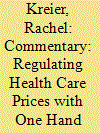|
|
|
Sort Order |
|
|
|
Items / Page
|
|
|
|
|
|
|
| Srl | Item |
| 1 |
ID:
174743


|
|
|
|
|
| Summary/Abstract |
Last year in this journal, I offered an explanation for America’s high health care costs rooted in the concept of “supply-side moral hazard,” and advocated for an all-payer system of price regulation as an appropriate policy response. The good news—particularly in the current time of pandemic—is that politicians and health services researchers are beginning to acknowledge the need for some form of price regulation. Legislative proposals thus far have focused narrowly on pharmaceutical prices and “surprise billing” for out-of-network charges. However, a few months ago, in March 2020, three Harvard researchers released a more comprehensive proposal. The bad news is that the proposal would preserve a large role for market forces, which, I argue here, amounts to going into battle against high health care costs with one hand tied behind your back. Furthermore, the reliance on private markets would lock in place the rampant inequality and Byzantine complexity bedeviling American health care.
|
|
|
|
|
|
|
|
|
|
|
|
|
|
|
|
| 2 |
ID:
168063


|
|
|
|
|
| Summary/Abstract |
In health care markets, moral hazard is conventionally viewed as a demand-side phenomenon in which insurance causes patients to use more care because it reduces the price they have to pay for care. However, demand-side moral hazard cannot explain why U.S. per capita health care costs are much higher than those of countries with universal coverage and lower out-of-pocket charges. Instead, blame rests with a phenomenon that may be called supply-side moral hazard, which occurs when third-party payment removes the constraints the demand curve would otherwise exert over the prices providers charge, and the quantity of expensive services they can sell. Public institutions are better positioned than private entities to address supply-side moral hazard. This helps explain why the other wealthy democracies—both those with single-payer systems, like Canada, and those with multipayer systems and all-payer procedures for setting provider rates, like Germany and Switzerland—spend much less per capita than the United States. Although managed care achieved some success in controlling U.S. provider prices in the 1990s, in the longer term, it motivated increasing market concentration among providers, which vitiated cost control. Furthermore, managed care exacerbates inequity and complexity, problems that public price regulation avoids.
|
|
|
|
|
|
|
|
|
|
|
|
|
|
|
|
|
|
|
|
|